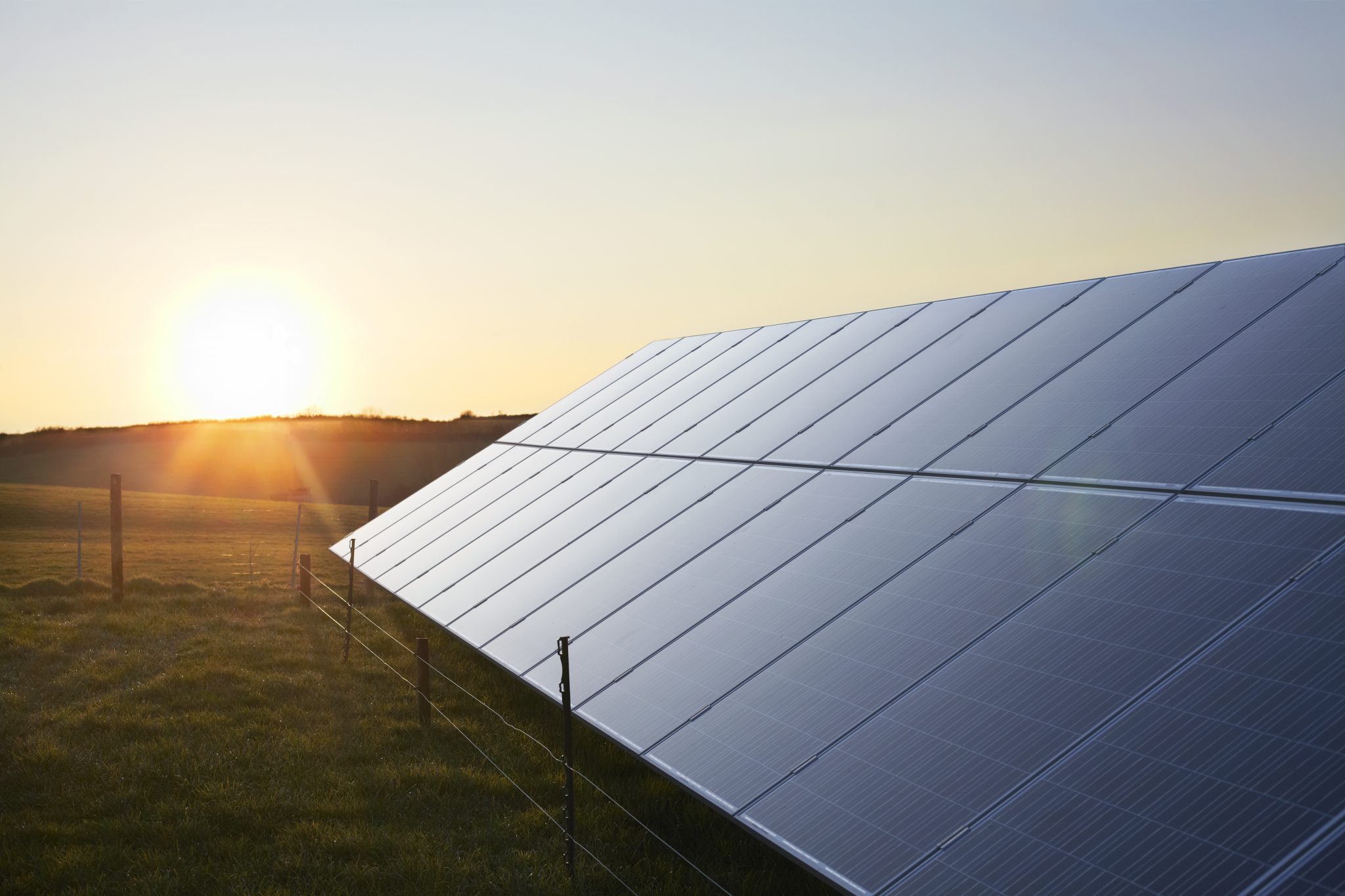Crop Production

Explore the variables involved in using solar power to determine if a solar energy system is the right choice for your farming operation.
Solar energy is the number-one renewable energy source utilized worldwide. But can it be beneficial to your farming operation? Can you make money using solar energy?
Of all the possible renewable sources of electrical energy, solar energy is the most abundant and easily accessible. According to the National Renewable Energy Laboratory (www.nrel.gov), “More energy from the sun falls on the earth in one hour than is used by everyone in the world in one year.”
Solar power can have a multitude of applications on the modern farm, but not all applications will benefit equally from solar options for power. The primary reason to consider solar is the potential to capture a free source of renewable energy and convert it into usable electricity at a long-term cost that is comparable to grid-purchased power. Solar power also can make electricity available where it otherwise is not.
One way to utilize the sun’s energy directly is to run an electric-powered component on the farm (figure 1).
Is Direct Usage Solar a Valid Consideration?
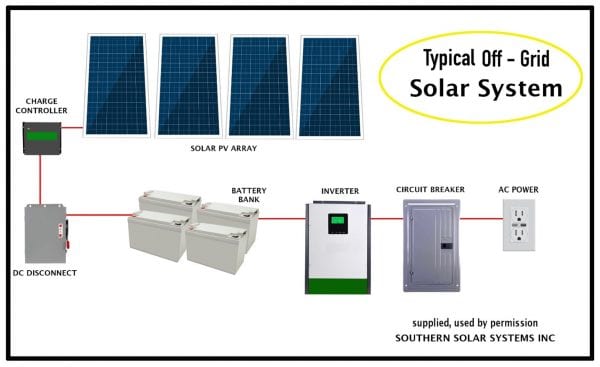
Figure 1. Direct usage solar is often called off-grid and consists of these basic components connected to convert solar energy on one end into AC power on the other end. This AC power can then be used to power any need on the farm.
Direct usage systems are often referred to as “stand- alone,” “off-grid,” or “micro-grid.” The source of solar energy is free but not unlimited. The sun does not always shine nor does it shine with the same level of intensity all the time. In the renewable energy world, this is called intermittency. It is the main problem with utilizing any renewable energy source, like solar.
If you are looking to produce and use electricity on-site to directly power a component of your farming operation, a series of questions must first be answered:
- How much power will my application require over time?
- Is utility grid power readily available?
- What is the full cost to purchase the electricity from the utility company?
- What is the usage profile of my application?
- What kind of solar power system will be required for my application and what is that cost over time?
Example: You are powering a small greenhouse that has fifty 10-watt LED lights that must burn continuously for 10 hours a day. They use 5.0 kWh/day (5,000 watt- hours), which translates to 152.5 kWh/month and 1,825 kWh/year. At a utility rate of $0.12/kWh, it costs $18.30/ month or $219/year to burn just the bulbs at the above usage. Since utility power is constant, your usage profile (when the power will be needed) does not factor into its cost.
The base utility charges for a single meter to supply our example greenhouse could be more than the $18.30 worth of power consumed each month. There may be additional charges that apply for utility grid power, especially in the case of a remote location with a dedicated power meter. A minimum connection fee will likely be charged regardless of actual power usage. If the location is very remote with no utility lines close by, the cost of bringing utility power to the location may be passed down to the customer as additional costs for poles or lines. All such fees and charges must be added up to know the total cost of utility power at any location. Only then can you make a smart business decision between utility power and solar power.
Knowing the full cost of utility-supplied electricity and converting that to cost per kWh used over time is the best way to compare two sources of electricity. For our example, we will assume that the grid power is a new connection, and the full cost of providing utility company electricity is $35/month in base charges plus a $1,000 connection cost spread out over 10 years, all totaling $520/year for 10 years. Those figures assume zero inflation or increases in base fees or utility rates over the 10-year time period. From these calculations, we can arrive at a final cost per kWh of grid power used over time (table 1).
Table 1. Estimated Cost Comparison of Utility-Supplied Electricity vs. Solar Power
*Assumes no increase in utility rates over the 10 year period, zero inflation.
**Typically, utility companies will charge whichever is higher - actual usage or base meter fee.
***This table is for cost evaluation explanatory purposes only and does not represent any specific utility company cost structure or solar system. Please check with your utility or solar provider for specific costs.
****Assuming “better” batteries with 10-year life and inverters with standard 10-year warranty.
| Monthly | Total 10 Year | |
|---|---|---|
| Utility Grid Power | ||
| kWh usage | 152.5 | 18,300 |
| $/kWh rate* | $0.12 | $0.12 |
| $ power usage ** | $18.30 | $2,196.00 |
| Base meter fee** | $35.00 | $4,200.00 |
| Install fee/cost | $8.33 | $1,000.00 |
| Total cost | $43.33 | $5,200.00 |
| Total cost/kWh | $0.28 | $0.28 |
| Direct Usage Solar Power - 2.5kW + 5kWh of Battery*** | ||
| kWh usage | 152.5 | 18,300 |
| PV Sys cost ($1.25/w) | $3,125.00 | |
| Battery cost ($200/kWh) | $1,000.00 | |
| Total system cost | $4,125.00 | |
| Interest - 5% | $9.38 | $1,125.00 |
| Maintenance**** | ||
| Total cost | $43.75 | $5,250.00 |
| Total cost / kWh | $0.29 | $0.29 |
Comparing Direct Usage Solar to Utility
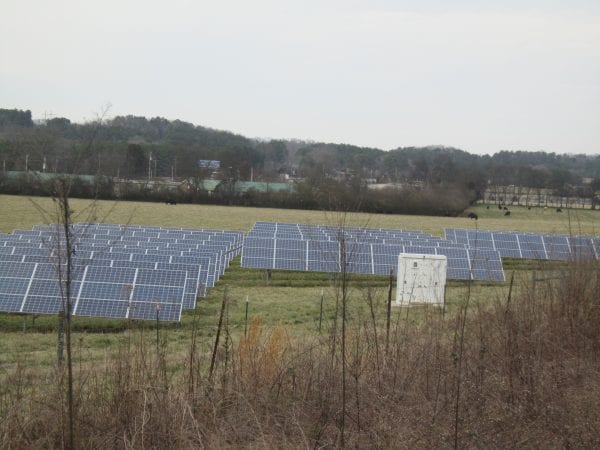 For a valid comparison, we need to calculate the cost of solar by the same standard. To start we must first consider the usage profile for our application. This simply means determining when we will need electricity. If our application needs power 24/7, or even if it will be needed sometimes when the sun is not shining, then a battery system will be required for direct usage applications to address the intermittency problem.
For a valid comparison, we need to calculate the cost of solar by the same standard. To start we must first consider the usage profile for our application. This simply means determining when we will need electricity. If our application needs power 24/7, or even if it will be needed sometimes when the sun is not shining, then a battery system will be required for direct usage applications to address the intermittency problem.
Since our greenhouse lights are set to run during the nighttime, we will need to use a battery system that stores enough power to run the lights for the full 10 hours or longer and enough solar panels to fully recharge the batteries as soon as sufficient solar is available.
It is highly recommended that you consult with a reputable solar energy installer at this stage. Once you know how much power you will need and when you will need it, a competent installer can design a system that fulfills your needs. Details to consider include the following:
- How will your location affect available solar over time?
- Can your application be out of power for any amount of time?
- What is the rate of battery discharge required to fulfill your needs?
Solar systems perform according to the amount of sun they receive. The production numbers indicated on the solar panel nameplate represent ideal, maximum- exposure conditions. The same solar panel located in Alabama will not produce as much as it will in Arizona. It will produce even less in Wisconsin.
The National Renewable Energy Lab’s PVWatts solar calculator (https://pvwatts.nrel.gov) can be used to estimate how much a solar system will produce at any location in the United States. Here are the steps:
- Go to the website, enter your zip code, and check the map to verify your location.
- Choose NREL International data.
- Go to “System Info” and input the size of the solar panels in “DC System Size.” The other variables can be left as the defaults for most applications. (The system also inputs the local average cost for utility grid power. This is used when considering net- metering or selling the produced power back to the utility grid, but it does not equate to a comparison of utility grid cost for your application.)
- Input various wattages of panel capacity into the program until the results yield sufficient power availability during the lowest solar months of December and January. For a typical location in North Alabama, the PVWatts results show us that 2.5kW of solar panels will provide the needed power in the lowest solar month of December (figure 2).
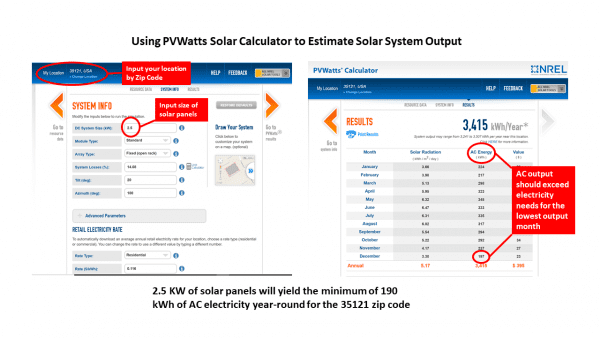
Figure 2. This PVWatts solar calculation shows that 2.5kW of solar panels will provide the needed power in the lowest solar month of December.
For a solar/battery system like our example above, the monthly solar output of the chosen watts of solar panel capacity should always exceed the amount of power needed to power the application for the same month as calculated above by at least 25 percent. In our example, this equals 190 kWh/month (153 kWh + 25 percent).
Choosing the Correct Storage
Batteries
Batteries will be required for a direct usage system without any grid connection needing power at night or year-round. You can think of it as a battery system that uses solar power to keep the batteries charged.
In our example greenhouse, the 5,000 watthours of power we need every day for continuous operation will dictate the battery size we need. The specifications of that battery will dictate the size of the solar array needed to keep it charged with the available sunlight. For many continuous operations, you want a battery that can last multiple days without much sunlight to recharge it.
You must choose the correct battery with enough total capacity to last your chosen length of time. When the battery needs charging, there must be enough solar power coming from the panels to run the electrical load as well as charge the battery. Even on cloudy days, quality solar panels will gather enough light to produce electricity, just at a reduced rate. A competent solar installer will understand the solar panel need according to your location to keep your battery charged even in winter when the sun is at its least.
Inverters and Chargers
The next step is choosing the correct solar inverter to convert the panel/battery DC power to AC. (This may not be needed if you plan to run DC-powered components for your application.)
The right inverter can handle the load over time without overheating and without causing disruptions in the power quality to your components. Again, this is where a competent solar installer is invaluable. Choosing the right inverter can make or break the success of the system.
An appropriate charge controller must also be used. This component is often part of the inverter function. The charge controller monitors the batteries and keeps them properly charged without overcharging. Wiring all the components together properly with the appropriately sized wires is the final step.
Once all these steps are completed, the final cost of the solar system can be analyzed. It may be as simple as taking a quote from a solar installer and considering that cost over time. Here are a few points to be considered with that kind of analysis:
- Quality photovoltaic (PV) solar panels typically are warranted to produce 80 percent or more of new panels for 25 years. They will continue to produce after but at a reduced rate of about 0.5 percent production decline per year.
- Batteries have various life expectancies depending on how they are used, their makeup, and their overall size. A good battery well suited for an application should last a minimum of 5 years, regardless of type. Better-quality batteries and the more advanced types available now can last multiple years longer but cost more up-front.
- Inverters can vary in life expectancy, as well, depending on the size and type. You should always purchase an inverter with a warranted life.
Solar Installer Quotes
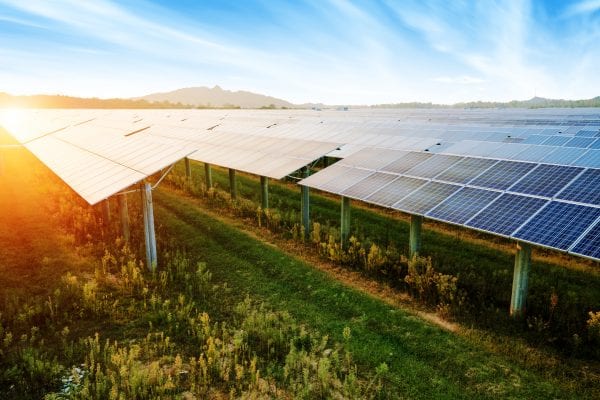 When getting quotes from a solar installer, ask for an estimated cost per kWh of power used over a specified length of time, as we see in table 1. Having a simple price per watt of installed solar panels is not sufficient for making a smart business decision, nor is it sufficient for comparing competing solar installers. You need to know how much it will cost for a system to deliver the power you need on a kWh basis to judge on equal terms.
When getting quotes from a solar installer, ask for an estimated cost per kWh of power used over a specified length of time, as we see in table 1. Having a simple price per watt of installed solar panels is not sufficient for making a smart business decision, nor is it sufficient for comparing competing solar installers. You need to know how much it will cost for a system to deliver the power you need on a kWh basis to judge on equal terms.
Make sure the solar estimates include interest if borrowing capital, maintenance, battery replacement, and system degradation over time. You pick the length of time and compare that to the same length of time using utility grid power on a $/kWh-used basis.
If installers do not supply an estimate in this manner, then take the total cost of the solar system, with all the additions mentioned above, and divide it by the total number of kWh to be used over the prescribed length of time. We suggest using 10 years as a basis for small systems of less than 5kW of solar panels and 25 years on larger systems.
Remember, while the overall life expectancy of solar panels exceeds 25 years, inverter and battery life is highly dependent on the quality and type chosen and will typically be the most time-limited factors of any system.
Installing a direct usage solar system can help solve a lot of problems in certain situations. Places where utility grid power is unavailable or expensive to acquire, or where the application has a low usage rate are prime opportunities to utilize these stand-alone or off-grid direct usage solar systems. As in every farming decision, however, it is imperative to make an economically sound business decision for the long term.
 Dennis Brothers, Associate Extension Professor, Farm and Agribusiness Management, Auburn University
Dennis Brothers, Associate Extension Professor, Farm and Agribusiness Management, Auburn University
New June 2021, Going Solar on the Farm: Implementing Solar Power in Agriculture, ANR-2789

